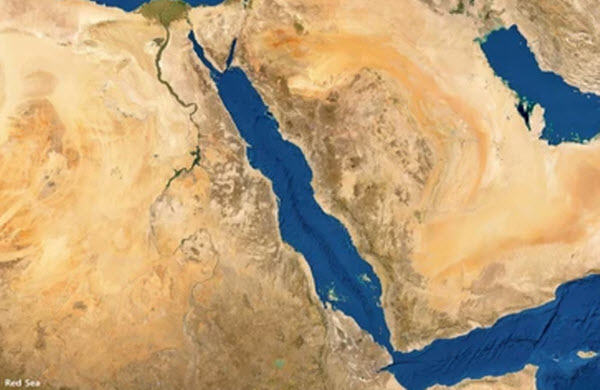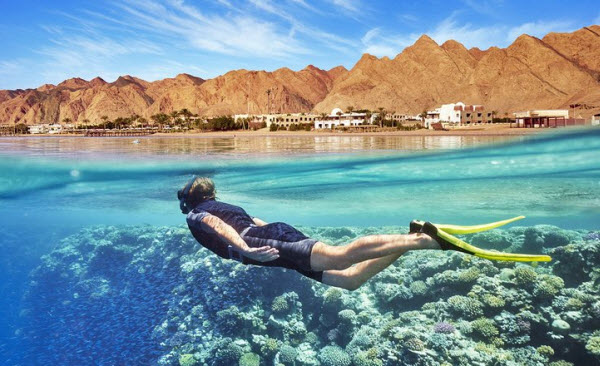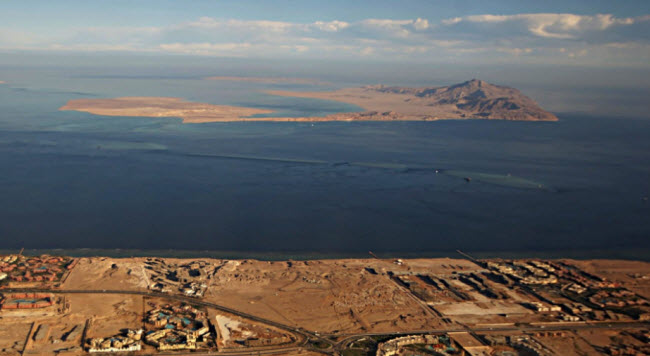The Red Sea is one of the saltiest bodies of water in the world and the northernmost tropical sea, located between Africa and Asia. It serves as an inlet to the Indian Ocean via the Bab el-Mandeb Strait and the Gulf of Aden in the south. To the north, it is bordered by the Sinai Peninsula, the Gulf of Aqaba, and the Gulf of Suez, which leads to the Suez Canal connecting it to the Mediterranean Sea. The Red Sea is part of the Great Rift Valley, covering an area of 450,000 square kilometers. It stretches approximately 1,900 kilometers long, with its widest point reaching 354 kilometers. The average depth is 500 meters, but it plunges to a maximum depth of 2,850 meters in the central trench. The Red Sea features extensive shallow shelves teeming with marine life and coral reefs, being home to over 1,000 species of invertebrates and 200 species of both hard and soft corals. Historically, the Red Sea has played a crucial role in maritime trade and acted as a bridge between coastal nations and empires to the east and west. Due to its rich biodiversity, the World Wildlife Fund (WWF) has designated the Red Sea as a global ecological region worthy of conservation.

Various theories explain how the Red Sea got its name. One theory attributes it to the seasonal blooms of a type of red-colored bacteria that grow in its waters. Another theory suggests that it may be named after nearby mountains that appear red. Some believe it’s linked to the Himyarite Kingdom, a local civilization, while a modern theory suggests that the name “Red Sea” could refer to the southern direction, similar to how the “Black Sea” refers to the north. This is based on the linguistic use of colors in some Asian languages to denote cardinal directions. Another theory connects the name to the Egyptian desert, which the ancient Egyptians called “deshret” or “the Red Land,” implying that the sea could be named after the red lands it borders.
The Red Sea has been explored since ancient times. The Egyptians were among the first to navigate it, seeking trade routes to the Land of Punt (modern-day Somalia) around 2500 BCE and again around 1500 BCE. Centuries later, in the 6th century BCE, Darius I of Persia sent exploratory missions to improve navigation in the sea, mapping hazardous rocks and currents. A canal was built connecting the Nile to the northern end of the Red Sea in the Gulf of Suez. In the late 4th century BCE, Alexander the Great sent Greek naval expeditions down the Red Sea to the Indian Ocean, which paved the way for further Greek exploration. The Roman Empire later utilized the sea for trade with India and imported goods from China through this route. During the Middle Ages, the Red Sea was integral to the spice trade. In 1798, France, under Napoleon Bonaparte, attempted to take control of Egypt and the Red Sea. Although Napoleon failed, his engineer, J.B. Le Pere, revived the ancient plan to build a canal, which eventually became reality with the opening of the Suez Canal in 1869. The canal remained under British and French control until it was nationalized by Egypt in 1956. Today, the Red Sea holds significant commercial importance as oil tankers pass through it from the Gulf to European and global markets.

The Red Sea was formed when the Arabian Peninsula separated from Africa due to tectonic plate movements. This split began in the Eocene epoch and accelerated during the Oligocene period. The sea continues to widen and is expected to eventually become an ocean. It also features several volcanic islands, most of which are dormant. Geographically, the Red Sea lies between arid desert and semi-desert lands. Its coral reef systems have flourished due to its deep waters and unique circulation patterns. The Red Sea’s water mass exchanges with the Arabian Sea and the Indian Ocean via the Gulf of Aden, which helps to mitigate the effects of high salinity caused by evaporation in the north and relatively warmer waters in the south. Despite this, the Red Sea remains one of the saltiest bodies of water, with salinity ranging from 36 to 38 parts per thousand. It spans 1,900 kilometers in length, reaching its maximum width of 354 kilometers near Eritrea and narrowing to just 30 kilometers at the Bab el-Mandeb Strait.
The Red Sea’s climate is characterized by two distinct seasons: the northeast monsoon and the southwest monsoon, caused by differences in heating between land and sea. Due to its high surface temperatures and elevated salinity levels, the Red Sea is one of the hottest bodies of water. During summer, surface water temperatures average around 26°C in the north and 30°C in the south, decreasing by about two degrees in winter. Overall, the average water temperature is 22°C. Rainfall over the Red Sea and its coasts is scarce and typically occurs in short bursts, often associated with thunderstorms or dust storms. The lack of freshwater sources and low precipitation leads to excessive evaporation, up to 205 cm annually, and high salinity levels with minimal seasonal variation. Tidal ranges vary, with an average of 0.6 meters in the north near the Gulf of Suez and 0.9 meters in the south near the Gulf of Aden.
Countries bordering the Red Sea include:
Northern Shore:
- Egypt
- Jordan
Eastern Shore:
- Saudi Arabia
- Yemen
Western Shore:
- Sudan
- Egypt
- Eritrea
Southern Shore:
- Djibouti
- Eritrea

The Red Sea boasts a rich and diverse ecosystem, with over 1,100 recorded species of fish, around 75 of which are deep-water species. Its 2,000 km of coral reefs, some as old as 7,000 years, form platforms and sometimes lagoons along the coast. Other marine habitats include seagrass beds, salt pans, mangroves, and salt marshes. Recognizing its biodiversity, the Egyptian government established the Ras Mohammed National Park in 1983, enforcing regulations to protect this region, which has become a major attraction for diving enthusiasts.

However, the Red Sea faces environmental threats. Desalination plants along its coast, particularly in Saudi Arabia, discharge warm saline effluent and chemicals that bleach and kill coral reefs, reducing fish stocks. These waters are also used for cooling in oil refineries and cement factories, and discharging the used water back into the sea harms the surrounding coastal environment.
